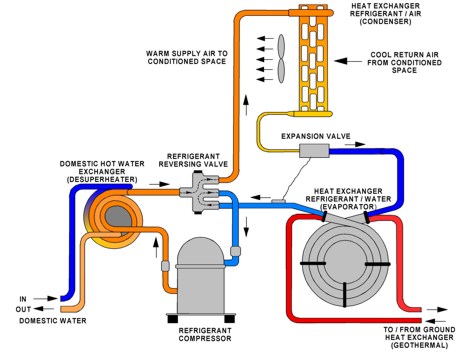With improving engineering technologies in recent decades, ground source geothermal heat pumps have become a highly energy-efficiency source of home heating and cooling. The basic technology has been around for over a century when Lord Kelvin discovered the principles of natural energy transfer in the 1850s.
Commercial applications of the technology began in in the early post-war era of the 1940s when various state governments began investigating ways to lower energy bills. Global adoption of the technology has been impressive, with widespread use in Europe, Asia and North America, and a rapidly accelerating adoption curve. With their dual use for heating and cooling, heat pumps benefit from stable underground temperatures throughout the year.
Relative to traditional forms of heating and cooling, geothermal heat pumps are vastly more efficient. Engineers have known for decades that traditional central-air and heating systems installed in most buildings are highly inefficient; geothermal installations can led to exponential improvements in overall energy transfer efficiency, resulting in less overall energy use and improved transfer quality rates.
During particularly extreme temperatures in the winter and summer, geothermal heat pumps retain their core transfer efficiency, allowing for vastly improved efficiency standards during these periods. While the pumps act as a supplemental source of energy regulation in many homes and buildings, improving technology has helped geothermal heat pumps to be responsible for a growing proportion of building energy regulation.
Based upon simple physical principles, geothermal pumps transfer heat from warm to cool areas in the summer, amplifying the natural energy flow, while they reverse the flow during the winter. The relatively stable earth temperatures make for greatly enhanced efficiency by way of a compressed refrigeration cycle. Simply, the system extracts the relatively warmer water during the winter and moves the heat back underground during the summer; the result is that the systems benefit from energy regulation throughout the year. For buildings in difficult climates such as extreme cold or heat, the systems deliver impressive energy efficiency gains which result in lower energy bills throughout the year.
At the core of the technology are mechanisms for ground heat exchange. This exchange occurs through a grounding medium such as a loop field, which are the source of the energy transfer. There are also traditional direct exchange geothermal pumps, which rely upon a single loop to transfer energy. The earlier systems relied upon this technology where a single copper tube carries refrigerant between the heating and cooling system and the external source. While these systems are more efficient than traditional technologies, they lack the overall efficiency of new technologies such as closed loop systems. Close loop heat pumps rely upon a refrigerant solution which exchanges energy with the ground in order to regulate internal temperatures in a natural manner.
Engineers continue to improve the underlying technology involved in heat transfer with more advanced materials and methods that result in better efficiency. With incentives from governments and private firms, households and businesses are aggressively adopting the technology at a rapid pace. Today, it’s common for new households to integrate geothermal heat pumps as part of the sustainability movement.
Geothermal heat pumps are available in your area, for more information Contact us today.

